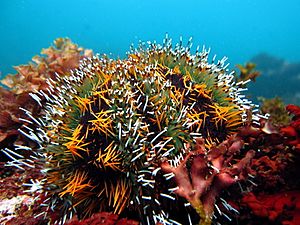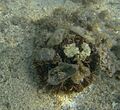Collector urchin facts for kids
The collector urchin (Tripneustes gratilla) is a cool type of sea urchin that lives in the ocean. These spiky creatures are found in warm waters around the Indo-Pacific, Hawaii, the Red Sea, and The Bahamas. They can grow to be about 10 to 15 centimeters (4 to 6 inches) wide.
Quick facts for kids Collector urchin |
|
|---|---|
 |
|
| Scientific classification | |
| Kingdom: | |
| Phylum: | |
| Class: | |
| Order: |
Temnopleuroida
|
| Family: |
Toxopneustidae
|
| Genus: |
Tripneustes
|
| Species: |
T. gratilla
|
| Binomial name | |
| Tripneustes gratilla (Linnaeus, 1758)
|
|
| Synonyms | |
|
Echinus gratilla |
|
Contents
What Does a Collector Urchin Look Like?
Collector urchins are usually dark, often bluish-purple, with white spines. They also have tiny tube feet, called pedicles, which are white with a dark base. Some collector urchins have orange-tipped spines, or even completely orange spines. However, these bright colors fade away when the urchin dies or is taken out of the ocean.
These urchins get their name because they often "collect" bits of debris on their bodies. They can grow to be about 10 to 15 centimeters (4 to 6 inches) across.
What Do Collector Urchins Eat?
Unlike some other sea urchins, collector urchins eat all the time, day and night! They graze close to the ocean floor. Their diet includes algae, tiny plant-like organisms called periphyton, and seagrass.
Most collector urchins love to munch on seagrass blades. This can really affect the seagrass beds, depending on the time of year and how many urchins are around. For example, between November and January, they eat a lot! One study found they could eat more than half of the seagrass produced during that time. Over a whole year, they eat about a quarter of the seagrass. The main types of seagrass they eat are Thalassodendron ciliatum and Syringodim isoetifolium.
Who Eats Collector Urchins?
Collector urchins are a tasty meal for some ocean animals. Their predators include puffer fish and octopus. Humans also sometimes eat them.
Where Do Collector Urchins Live?
Collector urchins are found in the warm waters of the Indo-Pacific, Hawaii, the Red Sea, and The Bahamas. You can find them from Mozambique all the way to Hawaii and even as far south as Port Jackson in Australia. They also live in Shark Bay on the west coast of Australia.
These urchins live at depths of about 2 to 30 meters (7 to 98 feet) underwater. Grown-up collector urchins like open areas on the seafloor where they can find some cover. However, young urchins prefer rocky spots where they can hide.
How Do Humans Interact with Collector Urchins?
Collector urchins are important for people in some parts of the world because they are edible. Sadly, because people have been taking too many of them, their numbers have dropped a lot over the last ten years. This is called overexploitation.
Helping Coral Reefs by Removing Invasive Algae
In Hawaii, aquatic biologists and divers worked together to help save coral reefs. On January 29, 2011, they placed 1,000 native collector urchins on a 500 square meter (5,382 sq ft) area of reef in Kāneʻohe Bay. Their goal was to control an invasive seaweed called Kappaphycus, also known as "smothering seaweed." This seaweed was taking over the local coral. Collector urchins are great at eating algae and stay on the reef, making them perfect for this job.
The urchins were raised at the Anuenue Fisheries Research Center. Scientists started with about a million tiny larvae. From these, they grew 25,000 young urchins that were at least 15 millimeters (0.6 inches) wide in about five months. The baby urchins were very delicate and had to be kept floating in the water column for weeks after they hatched. The plan is to release 10,000 to 25,000 urchins every month.
Kaneohe Bay is special because it's the only barrier reef system in the United States. The alien seaweed was brought to Hawaii for commercial uses, like keeping ice cream smooth. But it escaped into the ocean when the industry failed.
For many years, the state tried to remove the algae using a special marine vacuum pump. At one point, they removed 10,000 pounds of it! In 2009, scientists gathered urchins from other parts of Hawaii and released them in Kaneohe Bay. A year later, they saw that the urchins had successfully kept the seaweed under control.
Images for kids
-
Tripneustes gratilla covering itself with rocks (Réunion island).







